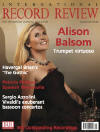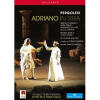Texte paru dans: / Appeared in:
*

International Record Review - (01/2012)
Pour
s'abonner / Subscription information
Opus Arte DVD
OA1065D

0809478010654
Back in 2010 I complained in these pages that the 300th anniversary of Pergolesi’s birth (1710) was being ignored by record companies. What we got were quite a few more recordings of the Stabat mater - as if we needed them - but not so much as a da capo aria from any of his neglected operas. 2010 was the perfect opportunity to raise a few of his six surviving opera serie from the dead and begin to judge the composer on the music which he held most dear. Of course what really happened was that quite a few of his operas were staged during the anniversary, it’s just that they’ve taken an age to reach us on CD or DVD. In June 2011 I warmly welcomed L’Olimpiade (1735) from Alessandro de Marchi and Academia Montis Regalis, recorded live during four performances at the Innsbruck Festival of Early Music in August 2010. Now we have its immediate predecessor Adriano in Siria (1734) staged in the exquisite eighteenth-century theatre in the composer’s native Jesi in June 2010 and conducted by the period specialist Ottavio Dantone.
This is the most impressive and engaging
product of Pergolesi’s anniversary year I’ve heard so far — and who knows
what else may be in the pipeline. Its not only the first film of a period
performance of one of his operas that I’ve come across, its also the first
on Blu-ray, and the first to include between its acts the original
accompanying comic intermezzo - Livietta e Tracollo - just what
audiences would have heard back in 1734. In short, Pergolesi the opera
composer has never had it so good.
He was only the third composer to set Metastasio’s libretto, and as always
it was adapted to suit local needs, in this case to enhance the role of
Farnaspe sung by the star alto castrato Caffarelli. The outlines of the plot
remained the same, though. In brief hard for an opera seria - the
tangled dramatic web spins around the love life of Adriano (Emperor
Hadrian). He’s betrothed to Sabina but now loves the imprisoned Emirena,
daughter of Osroa, the king of the Parthians, whom he has just defeated.
However, Emirena loves the Parthian prince Farnaspe and he loves her, and by
the end of the opera the two young lovers are united and Adriano returns to
Sabina.
Adriano in Siria was written for the great San Bartolomeo opera house in Naples to celebrate the birthday of the new king’s mother, Elisabeth Farnese, wife of Philip V of Spain. From what we can gather and such information is usually anecdotal - the work disappointed those who came to the opera only for the vocal pyrotechnics ... so most of the audience then. The opera is not in fact devoid of virtuoso display, its just that much of it is concentrated into a fairly small number of arias, some of the most dazzling of which were written for Caffarelli.
In this production Farnaspe is sung by mezzo Annamaria dell’Oste, who is more dramatically aware and dignified than simply dazzling: she never once plays to the gallery or drops out of character, though there were a few times when I wished she could exude just a little more star quality. Yet her seriousness pays rich dividends in the show-stopping ‘Torbido in volto e nero’, where her pirouetting cascades in the stratosphere are delivered with laser-beam precision, and the ornamentation of the da capo offers real dramatic intensification. This is one of the great eighteenth-century simile arias in which Farnaspe’s anxiety about trouble ahead is made manifest by the sounds of an approaching storm ‘turbulent and dark’. Pergolesi scored the piece for two orchestras, the second symbolizing the storm on the horizon, and was so pleased with the effect that he transplanted it unchanged to L’Olympiade the following year (along with several other arias). Here it’s done with terrific gusto, though for reasons of space the echoing second orchestra is created by single-string group within the main band.
In the title role soprano Marina Comparato has a lot of recitative but relatively few and comparatively short arias. Coupled with her slender stature, this all gives the impression of
a young, busy, impulsive monarch who listens to his heart more than his head. There’s a no-nonsense quality to her delivery, especially in the pithy recitatives, though not always absolute ringing precision in her top register. The two women Adriano loves could not be more different: the current heart-throb Emirena, sung with real feeling by the velvety mezzo Lucia Cirillo, and his official fiancée Sabina, sung by soprano Nicole Heaston. They are perhaps the two most attractively voiced singers in the cast. Heaston won me over immediately for her sumptuous combination of virtuoso brilliance, powerful delivery and breathtakingly accurate articulation. No wonder Adriano finally returns to her arms. She exudes everything a spurned but magnanimous lover should. King Osroa is sung by the only bloke in the cast, high baritone Stefano Ferrari, and it’s quite a shock to suddenly descend an octave or two to his level. He gets a terrific simile aria towards the end of Act 2 - never underestimate a wounded lion and he rises magnificently to the roaring of the orchestra (with horns) and Pergolesi’s powerful, striding vocal line. Once again, as with every singer here, the ornamentation of the da capo is beautifully judged to enhance the dramatic message but also to bring us to the edge of our seats.
The orchestral playing is exceptionally fine, with the very tight ensemble vividly captured by the microphones. Since many of Pergolesi ‘s accompaniments are essentially for unison violins underpinned by a simple bass line, Dantone has clearly spent a lot of rehearsal time working on phrasing and articulation — which brings the simplicity and beauty of Pergolesi’s writing out more effectively than I think I’ve ever heard it before in an opera. Dantone - a fine harpsichordist — also brings plenty of crisp punctuation and much-needed colour to the recitatives. For the charming Intermezzo, Livietta e Tracollo, the orchestra slims down to single strings.
Intermezzi were high-class interval entertainments which had no connection with the main opera and were performed by a separate group of specialist actor-singers. Plots were concerned with the lighter aspects of love and the comedy generally revolved around the humiliation of one character by the other: in Livietta e Tracollo both characters don disguises and get one over on each other before, of course, vowing eternal love and swearing to marry. So delightful are the high jinks and so catchy the tunes that you really can see why Livietta e Tracollo (and Pergolesi’s earlier La serva padrona) upstaged their parent works and went on to enjoy fame and fortune on their own. Soprano Monica Bacelli’s nimble, animated and very precise voice is the perfect vehicle for Pergolesi’s perk sparkling wit, and the gruff bass Carlo Lepore is the ideal foil. Excellent actors the pair of them, conducting much of their business in front of the orchestra and virtually in the laps of the front row ... and occasionally straying into the auditorium.
There’s some absolutely first-rate music here, both high- and low-brow, and cutting edge for the 1730s in its daring simplicity and directness. Act 2 of the opera in particular contains an almost unbroken succession of chart-topping arias, many of which remained popular for years after Pergolesi’s death. The production, though very straightforward, serves the music and drama well. All we have on stage is a pile of Roman ruins (lots of columns to hide behind) - the money has been spent instead on the exquisitely designed, eighteenth-century-based costumes. The filming and sound quality are stunning, and the Blu-ray is even better, with an extraordinary degree of clarity and presence. I’ve long wanted to experience the Italian - and especially Neapolitan - taste for interleaved opera and intermezzo - and the results here are nothing less than outstanding.
Cliquez l'un ou l'autre
bouton pour découvrir bien d'autres critiques de CD
Click either button for many other reviews


